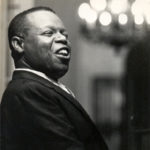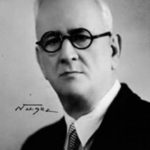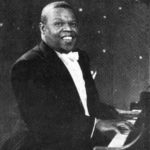
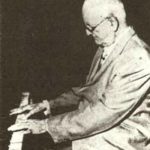 ANTONIO MARIA ROMEU Y ‘BOLA DE NIEVE’, GRANDES PIANISTAS Y COMPOSITORES CUBANOS.
ANTONIO MARIA ROMEU Y ‘BOLA DE NIEVE’, GRANDES PIANISTAS Y COMPOSITORES CUBANOS.
El 11 de septiembre se confabuló para traer al mundo en diferentes años a dos grandes pianistas y compositores de la música cubana: Antonio María Romeu Marrero e Ignacio Jacinto Villa y Fernández, popularmente conocido por ‘Bola de Nieve’.
En 1876 nace en Jibacoa, La Habana, el pianista, compositor y director de orquesta Antonio María Romeu, quien con solo 12 años tocó su primer baile y compuso su primera obra.La agrupación que fundó en 1910 con su nombre, especializada en la interpretación del danzón, lideró el género de la charanga por más de 30 años.
En la década del 30, incorporó a su orquesta al inigualable cantante Barbarito Díez, quien también la dirigiría tiempo después de morir Romeu el 18 de enero de 1955.Antonio María Romeu Marrero escribió más de 500 danzones; el más famoso de todos, “Tres lindas cubanas”.
https://youtu.be/FqGLKEI6DmE
Antonio María Romeu Marrero que nos dejo un 18 de Enero de 1955 fue maestro de los danzoneros, iniciador de las charangas francesas y promotor incansable de la música cubana. No sólo fue un pianista singular, sino también un destacado compositor, como lo demuestra en el tratamiento de las fórmulas pianísticas de variaciones que hizo en ‘Tres lindas cubanas’.
El sobrenombre de “El Mago de las Teclas” lo ganó por su maestría en el piano, ya que contribuyó a la consagración del danzón y compuso más de 500 temas, entre ellos ‘Marcheta’, ‘Cinta azul’, ‘Jibacoa’, ‘El mago de las teclas’ y muchos más.
Arregló para danzón numerosas canciones criollas, entre ellas ‘Guarina’ de Garay, ‘Me da miedo quererte’ de Villalón, ‘Mares y arenas’ de Ruiz, ‘Mercedes’ de Corona y ‘Perla Marina’ de Garay.
IGNACIO VILLA, “BOLA DE NIEVE”.
Este propio día, pero en 1911, nace en Guanabacoa, La Habana, el gran pianista y compositor cubano Ignacio Villa, conocido internacionalmente como Bola de Nieve. De un estilo muy personal,lograba comunicar su mensaje de forma ingeniosa a la manera de los viejos cuenteros.Además de ser un intérprete singular, compuso piezas antológicas, como “Si me pudieras querer”.
Bola de Nieve “Ay Mama Ines”.
“Si me pudieras querer/ como te estoy queriendo yo/ Si no me fuera traidora/ la luz de tu amor./ Yo no sé si existiera por ti sólo mi querer,/ yo no sé qué sería la vida sin ti… ”
Una letra sencilla y emotiva, salida de la pluma de alguien que no se consideraba compositor. Para él no era más que un intérprete, alguien que se entregaba a la interpretación al punto de sentir suyas incluso aquellas canciones que no eran de su autoría.
De él dijo Pablo Neruda: “Bola de Nieve se casó con la música y vive con ella en esa intimidad de pianos y cascabeles, tirándose por la cabeza los teclados del cielo. ¡Viva su alegría terrestre! ¡Salud a su corazón sonoro!”.
¿Quién le iba a decir a aquel negrito de Guanabacoa, que comenzó su carrera poniendo música a películas silentes en el cine Carral, de su ciudad natal, que un día tocaría y cantaría junto a artistas de la talla de Ernesto Lecuona, Esther Borja, Zoila Gálvez, Libertad Lamarque, Pedro Vargas, René Castelar o la propia Rita Montaner?
El 2 de octubre de 1971 murió Bola de Nieve en su querido México. El destino quiso que muriera fuera de su tierra, pues en cuestiones de nacionalidad, el Bola se reconocía sin ella, aunque sí decía sentirse, sobre todo, eminentemente latinoamericano.
Antonio María Romeu e Ignacio Villa, jovenes y viejos los conocemos por sus magnificas interpretaciones y actuaciones grabadas en viejas copias maltratadas por el tiempo, que a veces muestran en televisión y en nuestras páginas del Internet, donde aun se pueden apreciar aquellos dos gigantes de la música cubana. Solo nos quedan sus composiciones que serán eternas en el patrimonio de nuestra cultura.
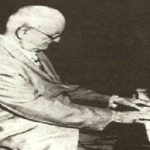
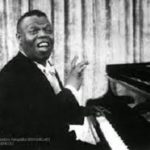 ANTONIO MARIA ROMEU AND ‘BOLA DE NIEVE’ (SNOW BALL), GREAT CUBAN PIANISTS AND COMPOSERS.
ANTONIO MARIA ROMEU AND ‘BOLA DE NIEVE’ (SNOW BALL), GREAT CUBAN PIANISTS AND COMPOSERS.
On September 11 he conspired to bring to the world in different years two great pianists and composers of Cuban music: Antonio María Romeu Marrero and Ignacio Jacinto Villa y Fernández, popularly known as Bola de Nieve.
In 1876 was born in Jibacoa, Havana, the pianist, composer and conductor Antonio Maria Romeu, who at only 12 years old played his first dance and composed his first work. The group he founded in 1910 with his name, specialized in the interpretation del danzón, led the genre of the charanga for more than 30 years.
In the decade of the 30, it incorporated to its orchestra the incomparable singer Barbarito Díez, who also would direct it time after Romeu dies the 18 of January of 1955. Antonio Maria Romeu Marrero wrote more than 500 danzones; the most famous of all, “Tres lindas cubanas”.
Antonio María Romeu Marrero, who left us on January 18, 1955, was a teacher of the danzoneros, initiator of the French brass bands and a tireless promoter of Cuban music. He was not only a singular pianist, but also an outstanding composer, as he demonstrates in the treatment of the piano formulas of variations he made in ‘Tres lindas cubanas’.
https://youtu.be/kisW6PUkiBo
Antonio Maria Romeu. “Timbalero”.
The nickname of “The Wizard of the Keys” won him for his mastery in the piano, since he contributed to the consecration of danzón and composed more than 500 songs, among them ‘Marcheta’, ‘Cinta azul’, ‘Jibacoa’, ‘ The wizard of the keys’ and many more.
Arranged for danzon numerous Creole songs, among them ‘Guarina’ by Garay, ‘Me que miedo quererte’ by Villalón, ‘Mares y arenas’ by Ruiz, ‘Mercedes’ by Corona and ‘Perla Marina’ by Garay.
IGNACIO VILLA, “BOLA DE NIEVE” (SNOW BALL).
This very day, but in 1911, the great Cuban pianist and composer Ignacio Villa, known internationally as Bola de Nieve, was born in Guanabacoa, Havana. In a very personal style, he managed to communicate his message in an ingenious way in the manner of the old storytellers. Besides being a singular interpreter, he composed anthological pieces, such as “Si me podrieras querer”.
“If you could love me / how I’m wanting you / If I were not traitor / the light of your love. / I do not know if I only wanted to exist for you, / I do not know what life would be without you …”
A simple and emotional lyrics, coming from the pen of someone who did not consider himself a composer. For him he was no more than an interpreter, someone who gave himself up to the interpretation to the point of feeling his own even those songs that were not his own.
Pablo Neruda said of him: “Bola de Nieve married the music and lives with her in that intimacy of pianos and bells, playing the keyboards of the sky. Live your earthly joy! Health to your sonorous heart! ”
Who would say to that little boy from Guanabacoa, who began his career putting music to silent films in the Carral cinema, from his hometown, that one day he would play and sing along with artists of the stature of Ernesto Lecuona, Esther Borja, Zoila Gálvez, Libertad Lamarque, Pedro Vargas, René Castelar or Rita Montaner herself?
On October 2, 1971, Bola de Nieve died in his beloved Mexico. Fate wanted him to die outside his land, because in matters of nationality, the Bola was recognized without it, although he said he felt, above all, eminently Latin American.
Antonio Maria Romeu and Ignacio Villa, young and old we know them for their magnificent performances and performances recorded in old copies battered by time, which they sometimes show on television and on our Internet pages, where you can still see those two giants of the Cuban music. We only have his compositions that will be eternal in the heritage of our culture.
Agencies/ RHC/ Various/ Maria Candela/ Extractos/ Internet Photos/ YouTube/ Arnoldo Varona/ www.TheCubanhistory.com
THE CUBAN HISTORY, HOLLYWOOD.
OVER 7,000 ARTICLES ABOUT CUBA. (SEARCH > www.TheCubanhistory.com



 < ANTONIO María Romeu and 'Bola de Nieve', Great Cuban Pianists and Composers. VIDEOS.
< ANTONIO María Romeu and 'Bola de Nieve', Great Cuban Pianists and Composers. VIDEOS.